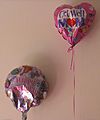Polyethylene terephtalate facts for kids
Polyethylene terephthalate, often called PET or PETE, is a type of plastic. It belongs to a group of plastics called polyesters. The chemical industry makes PET.
You can find PET in many everyday items. It is used to make synthetic fibers for clothes. It also makes bottles for drinks, food, and other liquids. PET is used in special packaging and strong plastic parts, sometimes mixed with glass fibers. It's one of the most important materials for making man-made fibers.
PET can be clear and see-through, or it can be white and opaque. This depends on how it is made and heated.
| PET | |
|---|---|
| Density | 1370 kg/m3 |
| Young modulus | 2800–3100 MPa |
| Tensile strength | 55–75 MPa |
| Elongation @ break | 50–150% |
| notch test | 3.6 kJ/m2 |
| Glass temperature | 75 °C |
| melting point | 260 °C |
| Vicat B | 170 °C |
| Thermal conductivity | 0.24 W/m.K |
| linear expansion coefficient (α) | 7×10−5/K |
| Specific heat | 1.0 kJ/kg.K |
| Water absorption (ASTM) | 0.16 |
| Price | 0.5–1.25 €/kg |
Most of the PET made around the world (over 60%) is used for man-made fibers, like those in clothing. About 30% of PET is used to make bottles. When we talk about clothes, PET is usually just called "polyester." But when we talk about packaging, it's usually called "PET."
What PET is Used For
Plastic Bottles
Plastic bottles made from PET are very common for soft drinks. These bottles are good because they can hold fizzy drinks. For special bottles, like those for beer, PET might have an extra layer of plastic called polyvinyl alcohol (PVOH). This layer helps stop oxygen from getting into the bottle.
Films and Sheets
A special type of PET film, called Biaxially oriented PET film, is often known by its brand name, "Mylar." This film can be made shiny and reflective by adding a very thin layer of metal to it. This makes it useful for many things, like flexible food packaging and thermal insulation, such as space blankets.
Because PET film is very strong, it is also used in tapes. For example, it can be the base for magnetic tape (like in old cassette tapes) or for sticky tapes.
PET sheets that are not stretched can be heated and shaped (this is called thermoforming) to make packaging trays and blister packs. If a special type of PET is used, these trays can even hold frozen dinners. This is because they can handle both freezing and oven temperatures. Both clear PET and BoPET are see-through. You can also easily add colors to PET sheets.
Other Uses
When PET is mixed with glass particles or fibers, it becomes much stronger and lasts longer.
PET is also used as a base material in thin solar cells.
A material called Terylene, which is a type of PET, is used in bell ropes. It helps protect the ropes from wearing out as they move through the ceiling.
Since late 2014, PET has been used as the inner lining in certain high-pressure gas cylinders. PET is much better at stopping oxygen from getting through than other plastics used before.
PET is also a popular material for 3D printing, and another related plastic called PETG is also used in 3D printing.
Images for kids
-
sails are often made of PET-fibers.
-
Sailcloth is typically made from PET fibers also known as polyester or under the brand name Dacron; colorful lightweight spinnakers are usually made of nylon.
-
Replacing terephthalic acid (right) with isophthalic acid (center) changes the PET chain, making it harder to crystallize and lowering its melting point.
-
Aluminized Mylar balloons filled with helium
See also
 In Spanish: Tereftalato de polietileno para niños
In Spanish: Tereftalato de polietileno para niños












